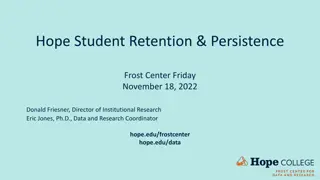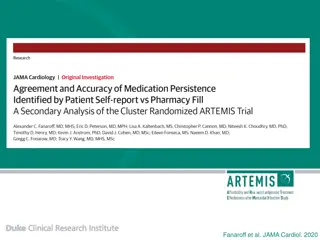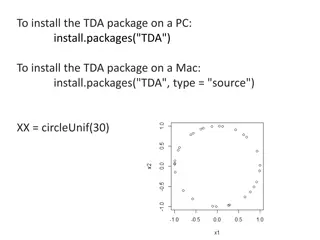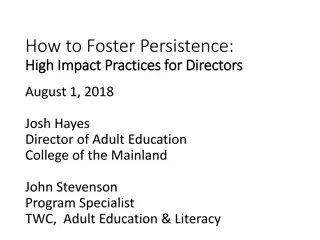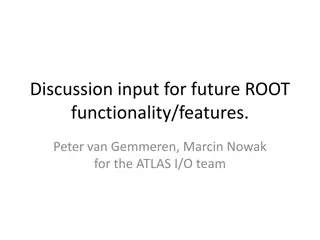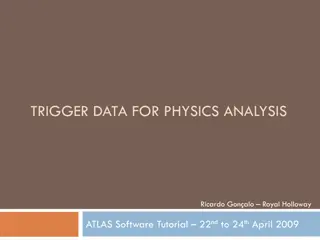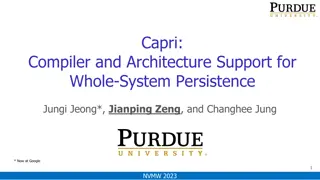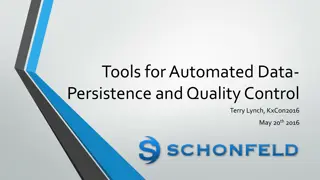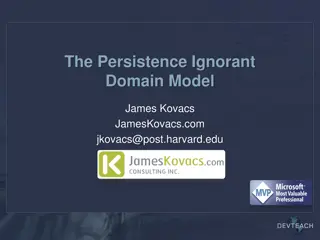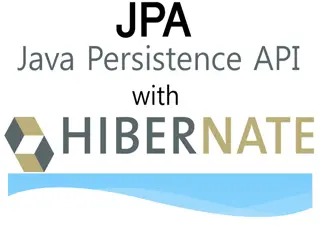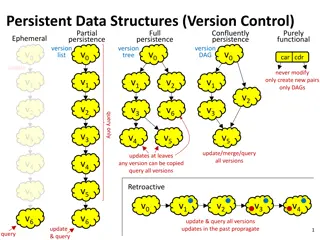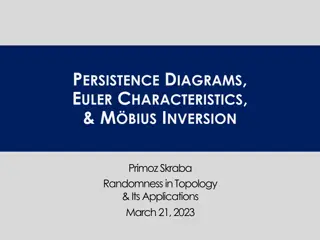Overview of ATLAS I/O Framework and Data Persistence
This overview provides a high-level understanding of the ATLAS Input/Output framework and data persistence, focusing on Athena as the event processing framework. It discusses the basics of ATLAS I/O, including writing and reading event data, as well as key components like OutputStream, EventSelector, and ConversionSvc. The document also covers different workflows in Reconstruction, Simulation, and Analysis within the Athena framework, emphasizing the processing stages and the ATLAS event data model implemented in C++. The article sheds light on the blackboard architecture of Athena and the types of outputs produced, such as xAOD and DxAOD.
Download Presentation

Please find below an Image/Link to download the presentation.
The content on the website is provided AS IS for your information and personal use only. It may not be sold, licensed, or shared on other websites without obtaining consent from the author. Download presentation by click this link. If you encounter any issues during the download, it is possible that the publisher has removed the file from their server.
E N D
Presentation Transcript
ATLAS I/O OVERVIEW Peter van Gemmeren (ANL) gemmeren@anl.gov 1 9/26/2019 Peter van Gemmeren (ANL): ATLAS I/O Overview
OVERVIEW The Basics: High level overview of ATLAS Input/Output framework and data persistence. Athena: The ATLAS event processing framework The ATLAS event data model Persistence: Writing Event Data: OutputStream and OutputStreamTool Reading Event Data: EventSelector and AddressProvider ConversionSvc and Converter More Details: Timeline Run 2: AthenaMP/Shared I/O, xAOD, EventService/Yoda Run 3: AthenaMT Run 4: Serialization, Streaming, MPI, ESP CCE Proposal: Discussion 2 9/26/2019 Peter van Gemmeren (ANL): ATLAS I/O Overview
THE BASICS 3 9/26/2019 Peter van Gemmeren (ANL): ATLAS I/O Overview
ATHENA: THE ATLAS EVENT PROCESSING FRAMEWORK Simulation, reconstruction, and analysis/derivation are run as part of the Athena framework: Using the most current (transient) version of the Event Data Model StoreGate is the Athena implementation of the blackboard: A proxy defines and hides the cache- fault mechanism: Upon request, a missing data object instance can be created and added to the transient data store, retrieving it from persistent storage on demand. Support for object identification via data type and key string: Base-class and derived-class retrieval, key aliases, versioning, and inter- object references. Athena software architecture belongs to the blackboard family: 4 9/26/2019 Peter van Gemmeren (ANL): ATLAS I/O Overview
WORKFLOWS AND I/O Athena is used for different workflows in Reconstruction, Simulation and Analysis (mainly Derivation). Total CPU evt-loop time Total Read (incl. ROOT and P->T) Total Write (w/o compression) Step ROOT compression EVNTtoHITS 0.006 0.01% 0.017 0.02% 0.027 0.03% 91.986 HITtoRDO 1.978 5.30% 0.046 0.12% 0.288 0.77% 37.311 RDOtoRDO- Trigger 0.125 1.23% 0.153 1.51% 0.328 3.23% 10.149 RDOtoESD 0.166 1.88% 0.252 2.85% 0.444 5.02% 8.838 ESDtoAOD 0.072 23.15% 0.147 47.26% 0.049 15.79% 0.311 AODtoDAOD 0.052 5.35% 0.040 4.06% 0.071 7.24% 0.979 RAWtoALL N/A N/A 0.112 0.72% 0.043 0.28% 15.562 5 9/26/2019 Peter van Gemmeren (ANL): ATLAS I/O Overview
THE ATLAS EVENT DATA MODEL The transient ATLAS event model is implemented in C++, and uses the full power of C++, including pointers, inheritance, polymorphism, templates, STL and Boost classes, and a variety of external packages. At any processing stage, event data consist of a large and heterogeneous assortment of objects, with associations among objects. The final production outputs are xAOD and DxAOD, which were designed for Run II and after to simplify the data model, and make it more directly usable with ROOT. More about this later 6 9/26/2019 Peter van Gemmeren (ANL): ATLAS I/O Overview
Dynamic Attr Reader On-demand single attribute retrieval PERSISTENCE Conv. Service Store Gate APR:Database ROOT POOL Svc On-demand single object retrieval Opt. T/P APR:Database ROOT ATLAS currently has almost 400 petabytes of event data Including replicated datasets ATLAS stores most of its event data using ROOT as its persistence technology Raw readout data from the detector is in another format. Input File Compressed baskets (b) Baskets (B) Persistent State (P) Transient State (T) read decompress stream t/p conv. 7 9/26/2019 Peter van Gemmeren (ANL): ATLAS I/O Overview
BACKUP SLIDE: WRITING EVENT DATA Sequence Diagram for writing Data Objects via AthenaPOOL: AthenaPool Output StreamTool connect Output() AthenaPool CnvSvc AthenaPool Converter PoolSvc Data Header new The AthenaPool- OutputStreamTool is used for writing data objects into POOL/APR files and hides any persistency technology dependence from the Athena software framework. setProcess Tag( pTag ) stream Objects() loop createRep (obj , addr ) createRep (obj , addr ) [object in item list] DataObject ToPool () T-P sep. [trans. -pers. conversion] transToPers obj,pObj ( ) registerForWrite place, pObj , desc ) registerForWrite ( (place, pObj , desc ) token token addr addr insert( addr ) Register get token and insert to self DataHeader in POOL, commit Output() commitOutput (outputName , true) alt [full commit] [else] commit() commitAndHold () 8 9/26/2019 Peter van Gemmeren (ANL): ATLAS I/O Overview
OUTPUTSTREAM AND OUTPUT- STREAMTOOL OutputStreams connect a job to a data sink, usually a file (or sequence of files). Configured with ItemList for event and metadata to be written. Similar to Athena algorithms: Executed once for each event Can be vetoed to write filtered events Can have multiple instances per job, writing to different data sinks/files OutputStreamTools are used to interface the OutputStream to a ConversionSvc and its Converter which depend on the persistent technology. 9 9/26/2019 Peter van Gemmeren (ANL): ATLAS I/O Overview
BACKUP SLIDE: READING EVENT DATA EventSelector AthenaPool next() PoolSvc Sequence Diagram for reading Data Objects via AthenaPOOL: alt getCollectionCnv () [no more events in collection] An EventSelector is used to access selected events by iterating over the input DataHeaders. Pool new CollectionCnv initialize() createCollection connection, input, context) (type, POOL:: ICollection create (type, des, mode, session) executeQuery () newQuery () iterator iterator An Address-Provider preloads proxies for the data objects in the current input event into StoreGate. [else] next () iterator loadAddr esses() retrieve( iterator , ref) eventRef () token retrieve(token) T-P sep. [pers. -trans. conversion] persToTrans dataHeader (ptr , ) DataHeader Element setObjPtr context) (ptr , token, dataHeader loop getAddress () [element != end()] 10 9/26/2019 Peter van Gemmeren (ANL): ATLAS I/O Overview
EVENTSELECTOR AND ADDRESS- PROVIDER The EventSelector connect a job to a data sink, usually a file (or sequence of files). For event processing it implements the next() function that provides the persistent reference to the DataHeader. The DataHeader stores persistent references and StoreGate state for all data objects in the event. It also has other functionality, such as handling file boundaries for e.g. metadata processing. An AddressProvider is called automatically, if an object retrieved from StoreGate has not been read. AddressProvider interact with ConversionSvc and Converter 11 9/26/2019 Peter van Gemmeren (ANL): ATLAS I/O Overview
MORE DETAILS 12 9/26/2019 Peter van Gemmeren (ANL): ATLAS I/O Overview
RUN 2, MULTI PROCESS: ATHENAMP In default mode, workers are independent of each others for I/O: Read their own data directly from file and write their own output to a (temporary) file. Input may be non-optimal as worker have to de-compress the same buffers to process different subsections of events -> cluster dispatching output from different workers needs to be merged, which can create a bottleneck -> deployment of SharedWriter Since Run II, ATLAS has deployed AthenaMP, the multi-process version of Athena. Starts up and initializes as single (mother) process. Optionally processes events Forks of (worker) processes that do the event processing in parallel. Utilizes Copy On Write, thereby saving large amounts of memory. Each worker has its own address space, no sharing of event data. 13 9/26/2019 Peter van Gemmeren (ANL): ATLAS I/O Overview
ATHENAMP WITH SHARED I/O 14 9/26/2019 Peter van Gemmeren (ANL): ATLAS I/O Overview
SHAREDWRITER The Shared Writer collects output data objects from all AthenaMP workers via shared memory and writes them to a single output file. This helps to avoid a separate merge step in AthenaMP processing. 15 9/26/2019 Peter van Gemmeren (ANL): ATLAS I/O Overview
SHAREDREADER The Shared Data Reader reads, de-compresses and de- serializes the data for all workers and therefore provides a single location to store the decompressed data and serve as caching layer. 16 9/26/2019 Peter van Gemmeren (ANL): ATLAS I/O Overview
MORE RUN 2, MULTI PROCESS: EVENTSERVICE AND YODA FOR HPC EventService uses fine grained processing to minimize potential loss and maximize parallelism Yoda is its implementation for HPC Both use AthenaMP as their payload processor. Producing lots of output files and accessing input data from many processes Potentially overburden File System Need support for fine grained I/O, see later. 17 9/26/2019 Peter van Gemmeren (ANL): ATLAS I/O Overview
ALSO RUN 2, XAOD DATA MODEL Each xAOD container has an associated data store object (called Auxiliary Store). Both are recorded in StoreGate. The key for the aux store should be the same as the data object with Aux. appended. The xAOD aux store object contains the static aux variables. It also holds a SG::AuxStoreInternal object which manages any additional dynamic variables. 18 9/26/2019 Peter van Gemmeren (ANL): ATLAS I/O Overview
XAOD: AUXILIARY DATA Most xAOD object data are not stored in the xAOD objects themselves, but in a separate auxiliary store. Object data stored as vectors of values. ( Structure of arrays versus array of structures. ) Allows for better interaction with root, partial reading of objects, and user extension of objects. Opens up opportunities for more vectorization and better use of compute accelerators. 19 9/26/2019 Peter van Gemmeren (ANL): ATLAS I/O Overview
RUN 3, MULTI THREAD: ATHENAMT Task scheduling based on the Intel Thread Building Blocks library with a custom graph scheduler. Data Flow scheduling: Algorithms declare their inputs and outputs. Scheduler finds an algorithm with all inputs available and runs it as a task. Algorithm data dependencies declared via special properties. Dependencies of tools will be propagated up to their owning algorithms. Flexible parallelism within an event. Can still declare sequences of algorithms that must execute in fixed order ( control flow ). Number of simultaneous eventsin flight is configurable 20 9/26/2019 Peter van Gemmeren (ANL): ATLAS I/O Overview
THINGS ABOUT ROOT ROOT is solidly thread safe: After calling ROOT::EnableThreadSafety() switches ROOT into MT-safe mode (done in PoolSvc). As long as one doesn t use the same TFile/TTree pointer to read an object Can t write to the same file In addition, ROOT uses implicit Multi-Threading E.g., when reading/writing entries of a TTree After calling ROOT::EnableImplicitMT(<NThreads>) (new! in PoolSvc). Very preliminary test show Calorimeter Reconstruction (very fast) with 8 threads gain 70 - 100% in CPU utilization 21 9/26/2019 Peter van Gemmeren (ANL): ATLAS I/O Overview
RUN 4: CHALLENGE FOR LHC COMPUTING Assuming ATLAS current compute model, CPU and storage needs for Run 4 will increase to a factor of 5-10 beyond what is affordable. The answer on how to mitigate the shortfall is better, wider and more efficient, use of HPC: ATLAS software, Athena, was written for serial workflow Migrated to AthenaMP in Run 2, but still dealing with improvements. Required only Core and I/O software changes. In process, but behind schedule, to move to AthenaMT for Run 3. Limited changes non-Core software, but clients need to adjust to new interfaces. Changes to allow efficient use of heterogeneous HPC resources (including GPU/accelerators) for Run 4 will be more intrusive. Figures taken from: arXiv:1712.06982v3 22 9/26/2019 Peter van Gemmeren (ANL): ATLAS I/O Overview
RUN3 -> RUN 4 ATLAS is currently reviewing its I/O framework and persistence infrastructure. Clearly efficient utilization of HPC resources will be a major ingredient for dealing with the increase of compute resource requirements in HL-LHC. Getting data onto and off of a large number of HPC nodes efficiently will be essential to effective exploitation of HPC architectures. SharedWriter already in production (e.g., in AthenaMP) and the I/O components already supporting multithreaded processing (AthenaMT) provide a solid foundation for such work A look at integrating current ATLAS shared writer code with MPI underway at ANL & LBNL 23 9/26/2019 Peter van Gemmeren (ANL): ATLAS I/O Overview
STREAMING DATA ATLAS already employs a serialization infrastructure for example, to write high-level trigger (HLT) results and for communication within a shared I/O implementation Developing a unified approach to serialization that supports, not only event streaming, but data object streaming to coprocessors, to GPUS, and to other nodes. ATLAS takes advantage of ROOT-based streaming. An integrated, lightweight approach for streaming data directly would allow us to exploit co-processing more efficiently. E.g.: Reading an Auxiliary Store variable (like vector<float> directly onto GPU (as float []). 24 9/26/2019 Peter van Gemmeren (ANL): ATLAS I/O Overview
CONCLUSION ATLAS has successfully used ROOT to store almost 400 Petabyte of event data. ATLAS will continue to rely on ROOT to support its I/O framework and data storage needs. At least for some of its workflows/data products. Run 3 and 4 will present challenges to ATLAS that can only be solved by efficient use of HPC and we need to prepare our software for this. ATLAS and ROOT 25 9/26/2019 Peter van Gemmeren (ANL): ATLAS I/O Overview
CCE PROPOSAL 26 9/26/2019 Peter van Gemmeren (ANL): ATLAS I/O Overview
FINE-GRAINED I/O AND STORAGE (IOS) Efficiently serialize and de-serialize multiple events in parallel within a node and across multiple nodes Have a persistent representation that provides efficient data access on HPC systems, optimized for HEP I/O patterns (specifically Write-Once Read-Many) Support partial reads from storage of only the data needed by a given algorithm Optimize memory layout of same data objects in sequential events to enable batch operations that span multiple events 27 9/26/2019 Peter van Gemmeren (ANL): ATLAS I/O Overview
BACKUP 28 9/26/2019 Peter van Gemmeren (ANL): ATLAS I/O Overview
TMPI FILE Work done by Amit Bashyal (CCE summer student, Advisor: Taylor Childers) and Yunsong Wang. TFile like Object that is derived from TMemFile and uses MPI Libraries for Parallel IO. Process data in parallel and write them into disk in TFile as output. Works with TTree cluster Worker collect events, compresses and sends to collector. 29 9/26/2019 Peter van Gemmeren (ANL): ATLAS I/O Overview


![[PDF⚡READ❤ONLINE] Road Atlas for the Total Solar Eclipse of 2024 - Color Editio](/thumb/21696/pdf-read-online-road-atlas-for-the-total-solar-eclipse-of-2024-color-editio.jpg)


